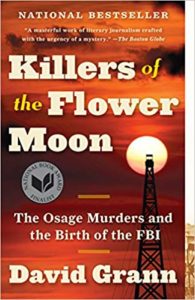 Killers of the Flower Moon: The Osage Murders and the Birth of the FBI by David Grann
Killers of the Flower Moon: The Osage Murders and the Birth of the FBI by David Grann Published by Vintage on April 3, 2018
Pages: 321
Format: Hardcover
Buy on Amazon
Goodreads

NEW YORK TIMES BESTSELLER - NATIONAL BOOK AWARD FINALIST
A New York Times Notable BookNamed a best book of the year by Amazon, Wall Street Journal, The Boston Globe, San Francisco Chronicle, GQ, Time, Newsday, Entertainment Weekly, NPR, Vogue, Smithsonian, Cosmopolitan, Seattle Times, Bloomberg, Lit Hub, and Slate
From the #1 New York Times best-selling author of The Lost City of Z, a twisting, haunting true-life murder mystery about one of the most monstrous crimes in American history. In the 1920s, the richest people per capita in the world were members of the Osage Nation in Oklahoma. After oil was discovered beneath their land, the Osage rode in chauffeured automobiles, built mansions, and sent their children to study in Europe. Then, one by one, the Osage began to be killed off. The family of an Osage woman, Mollie Burkhart, became a prime target. One of her relatives was shot. Another was poisoned. And it was just the beginning, as more and more Osage were dying under mysterious circumstances, and many of those who dared to investigate the killings were themselves murdered. As the death toll rose, the newly created FBI took up the case, and the young director, J. Edgar Hoover, turned to a former Texas Ranger named Tom White to try to unravel the mystery. White put together an undercover team, including a Native American agent who infiltrated the region, and together with the Osage began to expose one of the most chilling conspiracies in American history.
I read Killers of the Flower Moon on the recommendation of a friend. Some of my own family lived in Oklahoma at the time of the events described in this book, though they lived near the Texas border in the southern part of the state rather than near Osage County. This is not history you will likely hear about in school, partly because the victims are subsumed into the greater genocide that white Americans perpetrated against Native Americans.
The book has all the drama of a true crime story. In spite of the fact that the book opens with several Osage murders, the pace is a bit boggy until Grann begins to unravel the web of deceit and murder at the heart and uncovers the vast murder conspiracy to defraud the Osage of their money and oil headrights. It was also difficult to keep up with the large number of people in the story, and a table or glossary of some kind would have helped. Still, the story is riveting, and once the pace picks up, the story is hard to put down and moves swiftly. Punctuated with photographs throughout and descriptions of Osage County, the story also evokes the setting, placing the reader right there in the midst of the events.
Reading this book for me had me wondering about my own family history. Many of my ancestors lived in Oklahoma when it was still “Indian Territory.” My great-great-grandmother is listed on the 1900 U.S. Census as living in “Chickasaw Nation, Indian Territory.” I have never heard any stories about their relationships with Native Americans. Of course, there is the ubiquitous untrue story about having Native American ancestry in the family. Later on, my grandmother was born in the same area of the state, and I remember visiting my great-grandparents while they were living in Ardmore, OK. In fact, I still have a lot of family living there. I remember my great-grandmother’s younger brother Willard, who grew yellow watermelons and sold them. I remember his twin sister Wilma, who introduced me to German chocolate cake. Looking at the faces of white people in the photographs in Grann’s book was like looking at my own family members. It reminded me again how connected all of us really are and how much of what happened in the past still touches us in the present.